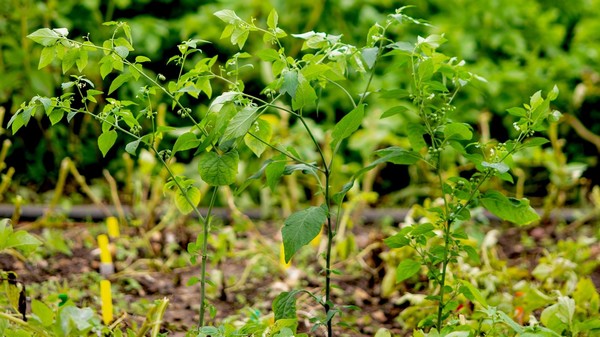An international team of researchers has made significant progress in the fight against the infamous potato disease Phytophthora infestans. A new gene found in the plant Solanum americanum (family of the widespread wild plant black nightshade) has been shown to make potatoes resistant to nineteen tested variants of P. infestans. A publication on this new Rpi-amr1 gene appears this afternoon in Nature Plants.
The fungus Phytophthora infestans causes late blight and has led to major famines and social unrest in the past. Even today, the disease can lead to devastating losses. Chemical control also places a great burden on the environment.
Resistance genes can ensure that plants recognize the so-called avirulence protein of Phytophthora. This recognition leads to a rapid immune response (the hypersensitivity reaction, a rapid local cell death of the attacked plant cells) and this stops the infection.
In recent decades, a considerable number of resistance genes have been isolated from wild potato varieties, especially from South and Central America. However, these resistance genes have a major disadvantage: Phytophthora infestans can mutate avirulence genes relatively quickly, as a result of which the avirulence proteins are no longer recognized and the immune response does not occur. We then say that the resistance genes have been ‘broken’. This is (unfortunately) commonplace.
In recent decades, a considerable number of resistance genes have been isolated from wild potato varieties, especially from South and Central America. However, these resistance genes have a major disadvantage: Phytophthora infestans can mutate avirulence genes relatively quickly, as a result of which the avirulence proteins are no longer recognized and the immune response does not occur. We then say that the resistance genes have been ‘broken’. This is (unfortunately) commonplace.

Solanum americanum
Researchers from England, in collaboration with Wageningen University & Research (WUR) and fellow researchers in Germany, have succeeded in isolating new broad-spectrum resistance genes from Solanum americanum. This plant is known for not being affected by late blight.
The isolated new resistance genes (Rpi-amr1) appear to have a number of special features. For example, they recognize the conserved avirulence genes (Avramr1) of Phytophthora infestans. These conserved avirulence genes do not change as quickly and even appear to be conserved in a number of other Phytophthora species that pose a threat to other plant species.
Wider and more durable resistance
Although they differ slightly from each other, each Rpi-amr1 variant allows the plant to detect the same virulence proteins. Infection trials with an extensive set of nineteen P. infestans isolates from different geographic locations confirm that Rpi-amr1 resistance is very broad. No P. infestans isolate could affect potato leaves transformed with Rpi-amr1.
And since Solanum americanum plants are known as ‘non-host’ for Phytophthora, the selection pressure on the avirulence gene will be considerably lower. It is therefore expected that the Rpi-amr1 resistance is more durable than could be achieved with other resistance genes.

Maris Piper
The resistance gene Rpi-amr1 is now being combined with two other resistance genes (Rpi-amr3 and Rpi-vnt1) in the commercial potato Maris Piper. The resulting potato lines are immune to a very wide variety of Phytophthora isolates.
Project partners The study was conducted in collaboration with The Sainsbury Laboratory and the John Innes Center in Norwich, the Universities of East Anglia, Leesd and Hull and the Technical University of Munich.









